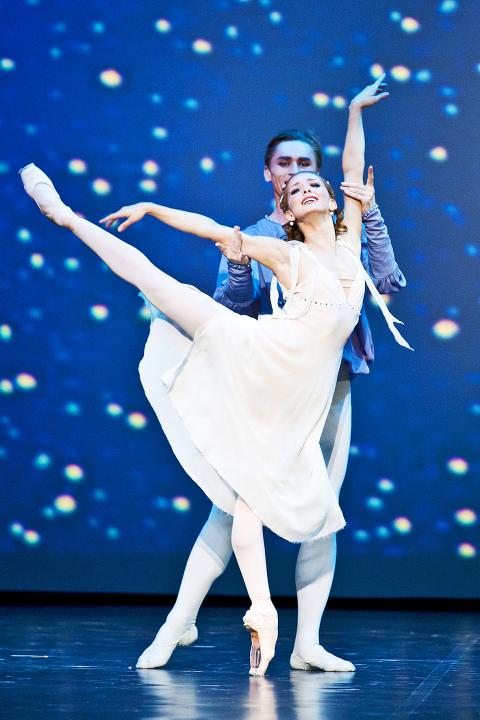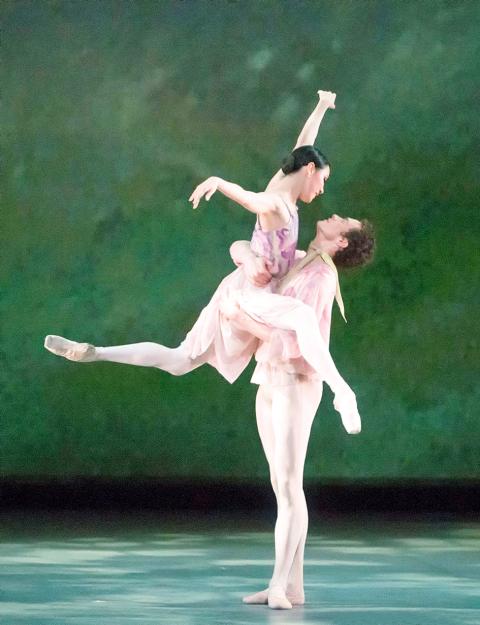Just over two months after staging the 12th International Ballet Star Gala in Taipei and Taichung, Wang Tzer-shing (王澤馨) is headed back to Taichung for a one-night show with another stellar line-up of principal dancers from some of the world’s leading companies.
It will be the second ballet gala that Art Wave, the company run by Wang and her husband Chat Tzongue (謝宗益), has staged just for National Taichung Theater, following a production in February last year.
While there will be some familiar faces, such as the Mariinsky Theater’s Igor Kolb, who has danced in almost every one of the couple’s galas, including the two in Taichung, there are several who are less familiar to local audiences, such as Kolb’s Mariinsky colleagues Alexander Sergeev and Elena Evseeva, and Lee Sangeun from the Dresden SemperOpera Ballett.

Photo courtesy of Art Wave Inc
The rest of the line-up is equally stellar: Paris Opera Ballet star Dorothee Gilbert, Evgenia Obraztsova from the Bolshoi Theatre, the husband and wife duo Elisa Carrillo Cabrera and Mikhail Kaniskin from the Staatsballett Berlin, Lee’s Dresden’s colleague Raphael Coumes-Marquet and the American Ballet Theater’s Hee Seo and Cory Stearns.
Thursday’s program promises to be interesting for a variety of reasons, not least of which is the number of solos that will be performed and the mixing and matching of partners.
Usually dancers from the same company perform together, but Sterns will be partnering Hee in an excerpt of Anthony Tudor’s famed The Leaves Are Fading and the Sleeping Beauty Pas de Deux, as well as Gilbert in an excerpt from Kenneth MacMillan’s Manon; while Kolb will partner Obraztsova in an excerpt from Leonid Lavrovsky’s Romeo and Juliet and then dance Tango, choreographed by Sanchez Blok, with Sergeev, which just had its world premiere in June in Poland.

Photo courtesy of Gene Schiavone
George Balanchine’s Jewels will be represented by two variations, Carrillo Cabrera will perform the solo from the Emeralds segment and Lee and Comes-Marquet will dance the pas de deux from the Diamonds segment.
Other solos include Obraztsova in Vladimir Vasiliev’s Sentimental Waltz, Gilbert in Mikhail Fokine’s short but classic The Dying Swan, and Evseeva will dance Nikiya from Marius Petipa’s La Bayadere.
Among the more modern works on the program are an excerpt from Nacho Duato’s Multiplicity. Forms of Silence and Emptiness, which will be danced by Carrillo Cabrera and Kaniskin; and David Dawson’s The Grey Area, performed by Lee and Comes-Marquet.
Rounding out the program are Evseeva and Sergeev in Vasily Vainonen’s Moskovsky Waltz, a 1940 piece for the Bolshoi, and Christian Spuck’s The Grand Pas de Deux, danced by Carrillo Cabrera and Kaniskin.
Wang has been raising the barre every year with her galas and they have yet to disappoint. The Taichung program looks like another winner.

May 26 to June 1 When the Qing Dynasty first took control over many parts of Taiwan in 1684, it roughly continued the Kingdom of Tungning’s administrative borders (see below), setting up one prefecture and three counties. The actual area of control covered today’s Chiayi, Tainan and Kaohsiung. The administrative center was in Taiwan Prefecture, in today’s Tainan. But as Han settlement expanded and due to rebellions and other international incidents, the administrative units became more complex. By the time Taiwan became a province of the Qing in 1887, there were three prefectures, eleven counties, three subprefectures and one directly-administered prefecture, with

It’s an enormous dome of colorful glass, something between the Sistine Chapel and a Marc Chagall fresco. And yet, it’s just a subway station. Formosa Boulevard is the heart of Kaohsiung’s mass transit system. In metro terms, it’s modest: the only transfer station in a network with just two lines. But it’s a landmark nonetheless: a civic space that serves as much more than a point of transit. On a hot Sunday, the corridors and vast halls are filled with a market selling everything from second-hand clothes to toys and house decorations. It’s just one of the many events the station hosts,

Among Thailand’s Chinese Nationalist Party (KMT) villages, a certain rivalry exists between Arunothai, the largest of these villages, and Mae Salong, which is currently the most prosperous. Historically, the rivalry stems from a split in KMT military factions in the early 1960s, which divided command and opium territories after Chiang Kai-shek (蔣介石) cut off open support in 1961 due to international pressure (see part two, “The KMT opium lords of the Golden Triangle,” on May 20). But today this rivalry manifests as a different kind of split, with Arunothai leading a pro-China faction and Mae Salong staunchly aligned to Taiwan.

Two moves show Taichung Mayor Lu Shiow-yen (盧秀燕) is gunning for Chinese Nationalist Party (KMT) party chair and the 2028 presidential election. Technically, these are not yet “officially” official, but by the rules of Taiwan politics, she is now on the dance floor. Earlier this month Lu confirmed in an interview in Japan’s Nikkei that she was considering running for KMT chair. This is not new news, but according to reports from her camp she previously was still considering the case for and against running. By choosing a respected, international news outlet, she declared it to the world. While the outside world